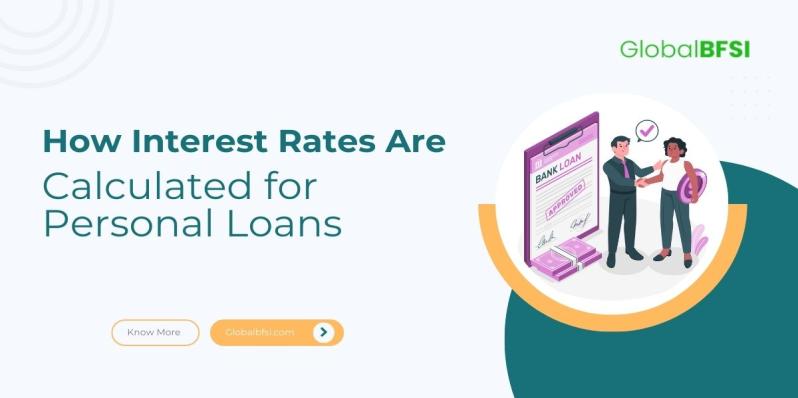- admin's Blog
- Log in or register to post comments

When you're thinking about a personal loan, knowing how interest rates work can be a game-changer. A personal loan can be used to pay for unexpected expenses, merge debt, or fund big-ticket purchases. But the interest you pay can really add up to the overall cost of the loan. In this blog, we'll explain how personal loan interest rates are calculated and provide advice on how to get the best rate possible.
What Is a Personal Loan?
Being unsecured, a personal loan doesn't require you to pledge assets such as a house or car as collateral. Personal loans are usually borrowed for any type of purpose, such as medical bills, home improvements, weddings, or credit card consolidation.
Since personal loans don't require collateral, lenders assess risk based on your financial profile, making interest rates vary widely depending on individual factors.
What Determines Interest Rates on a Personal Loan?
Your personal loan's interest rate is influenced by several key factors that lenders consider:
Credit Score and Credit History
Your credit score is perhaps most significant. A better credit score indicates that you have a pattern of using credit responsibly, reducing the lender's risk — and your interest rate. Borrowers with excellent credit usually qualify for the best personal loan rates.
Income and Job Stability
Lenders favor borrowers who demonstrate steady and adequate income. A steady job or regular income stream shows your ability to repay the loan, which can lead to a lower interest rate.
Debt-to-Income Ratio
The debt-to-income (DTI) ratio shows the portion of your monthly income that is used to pay off debts. A lower DTI ratio signals that you have enough income left over after paying debts, making you a less risky borrower.
Loan Amount and Loan Tenure
The size of your loan and the time you choose to repay it (loan tenure) can also affect your rate. Generally, larger loans or longer repayment periods may carry slightly higher interest rates to compensate for increased risk.
Lender’s Policies and Market Trends
Each lender sets its own personal loan interest rates based on internal risk models and external economic factors, such as central bank rates and market competition.
How Lenders Calculate Personal Loan Interest Rates
Understanding the calculation method can help you make smarter borrowing decisions. Here’s a closer look:
Base Rate + Risk Premium
Most lenders begin with a baseline rate (the lowest profitable rate) and add on a risk premium for the creditworthiness of the borrower. Increased borrower risk results in higher premiums and interest rates.
Fixed vs. Variable Rates
Some lenders offer fixed interest rates, where your monthly payments remain the same throughout the loan term. Others offer variable (floating) rates, which can change depending on market conditions.
Annual Percentage Rate (APR)
The APR includes not just the interest but also any fees associated with the loan, giving you a more complete picture of the true cost. Always compare APRs when shopping for personal loans.
Types of Interest Rates for Personal Loans
Understanding the type of interest rate you agree to is crucial:
Fixed Personal Loan Rates
Fixed rates provide stable interest and monthly payments, simplifying long-term financial planning.
Variable Personal Loan Rates
Variable rates can fluctuate based on market changes. While they may start lower than fixed rates, they can rise, making your monthly payments unpredictable.
Tips for Securing the Best Interest Rate on Your Personal Loan
Want to secure a lower rate? Here are some practical tips:
- Improve Your Credit Score: Make timely bill payments, reduce outstanding debt, and review your credit report for any errors.
- Compare Multiple Lenders: Don’t settle for the first offer. Find the best deals by comparing online and in-store rates.
- Consider a Shorter Loan Term: Shorter loan tenures usually attract lower interest rates.
- Apply During Promotions: Some lenders offer lower rates during special promotions or to specific groups like existing customers.
By following these steps, you can greatly lower the cost of your personal loan.
Common Errors to Avoid During Personal Loan Applications
Even savvy borrowers make mistakes. Here’s what to watch out for:
- Not Checking Additional Fees: Apart from interest, loans may have processing fees, prepayment penalties, and other hidden charges.
- Focusing Only on EMI: A lower EMI might seem attractive, but it could mean paying more in total interest over a longer period.
- Ignoring the Loan Terms: Always read the fine print to avoid surprises later.
Conclusion
Understanding how personal loan interest rates are calculated empowers you to make better financial choices. By knowing what factors affect your rates and how lenders evaluate your application, you can take steps to qualify for a better deal. Always compare options, read the terms carefully, and plan your repayment strategy before signing the loan agreement.
Read More:- Secured vs Unsecured Personal Loans: What’s the Difference?
